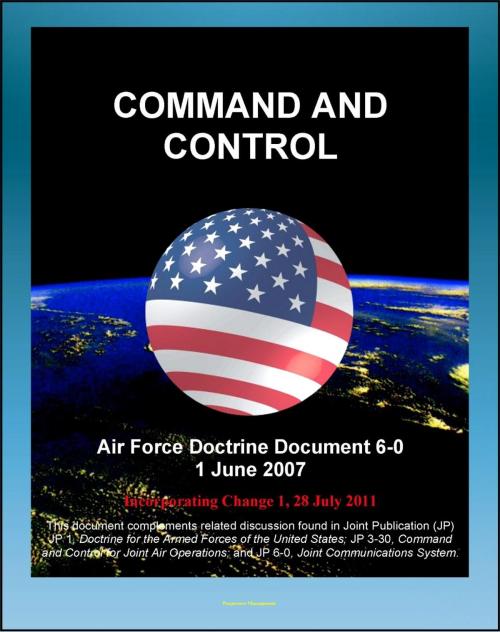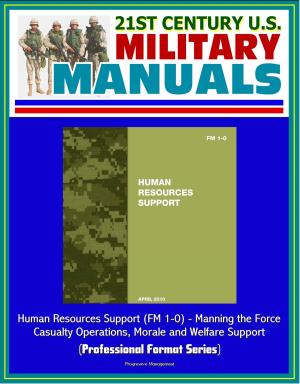Air Force Doctrine Document 6-0: Command and Control - C2 Processes, Planning, Technology, Training, Transfer of Forces and Command Authority
Nonfiction, History, Military, Aviation| Author: | Progressive Management | ISBN: | 9781476377483 |
| Publisher: | Progressive Management | Publication: | April 23, 2012 |
| Imprint: | Smashwords Edition | Language: | English |
| Author: | Progressive Management |
| ISBN: | 9781476377483 |
| Publisher: | Progressive Management |
| Publication: | April 23, 2012 |
| Imprint: | Smashwords Edition |
| Language: | English |
"Command and control" is one of the key operational functions as described in Air Force Doctrine Document 1, Air Force Basic Doctrine. It is the key operational function that ties all the others together to achieve our military objectives. Our doctrine for command and control rests on the Air Force tenets of centralized control and decentralized execution. A commander of Air Force forces will be designated whenever Air Force forces are presented to a joint force commander. This designation provides unity of command. An Airman is normally designated as the joint force air and space component commander, resulting in clear lines of authority for both joint and Air Force component operations. We organize, train, and equip Airmen to execute the myriad tasks of command and control of air, space, and cyberspace forces through Air Force global and theater command and control systems.
Command and control of air and space power is an Air Force-provided asymmetric capability that no other Service or nation provides. We use a variety of means to leverage this capability. While we employ our command and control through various systems, our focus is on our most important asset, our people. All Airmen must be trained and educated to be command and control professionals. While we have a cadre of command and control operators, most Airmen will use the principles and tenets of command and control in employing forces at some point in their service to our nation. We must be prepared through effective training and education to perform these critical tasks.
Our doctrine is broadly stated to fit varying levels of contingencies and diverse geographical areas, while encompassing joint and multinational operations. Our doctrine will support effective employment of the various Air Force capabilities necessary to achieve an effects-based approach to operations. Airmen conduct operations and learn from those experiences every day. They are finding innovative ways to improve our command and control processes and technical capabilities. We must use these experiences to improve our doctrine to continue to support our national military objectives worldwide.
Contents: Chapter One - Foundations of Command and Control (C2) * Chapter Two - Air Force C2 in the Administrative Chain of Command * Chapter Three - Air Force C2 in the Operational Chain of Command * Chapter Four - Command and Control Processes * Chapter Five - Technology Attributes and Developing C2 Professionals
"Command and control" is one of the key operational functions as described in Air Force Doctrine Document 1, Air Force Basic Doctrine. It is the key operational function that ties all the others together to achieve our military objectives. Our doctrine for command and control rests on the Air Force tenets of centralized control and decentralized execution. A commander of Air Force forces will be designated whenever Air Force forces are presented to a joint force commander. This designation provides unity of command. An Airman is normally designated as the joint force air and space component commander, resulting in clear lines of authority for both joint and Air Force component operations. We organize, train, and equip Airmen to execute the myriad tasks of command and control of air, space, and cyberspace forces through Air Force global and theater command and control systems.
Command and control of air and space power is an Air Force-provided asymmetric capability that no other Service or nation provides. We use a variety of means to leverage this capability. While we employ our command and control through various systems, our focus is on our most important asset, our people. All Airmen must be trained and educated to be command and control professionals. While we have a cadre of command and control operators, most Airmen will use the principles and tenets of command and control in employing forces at some point in their service to our nation. We must be prepared through effective training and education to perform these critical tasks.
Our doctrine is broadly stated to fit varying levels of contingencies and diverse geographical areas, while encompassing joint and multinational operations. Our doctrine will support effective employment of the various Air Force capabilities necessary to achieve an effects-based approach to operations. Airmen conduct operations and learn from those experiences every day. They are finding innovative ways to improve our command and control processes and technical capabilities. We must use these experiences to improve our doctrine to continue to support our national military objectives worldwide.
Contents: Chapter One - Foundations of Command and Control (C2) * Chapter Two - Air Force C2 in the Administrative Chain of Command * Chapter Three - Air Force C2 in the Operational Chain of Command * Chapter Four - Command and Control Processes * Chapter Five - Technology Attributes and Developing C2 Professionals















